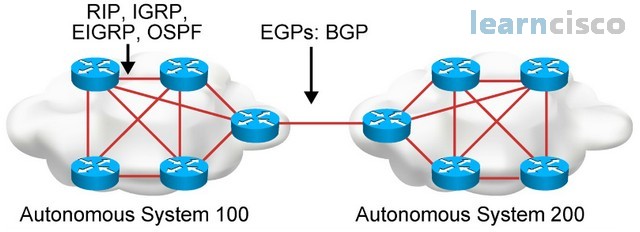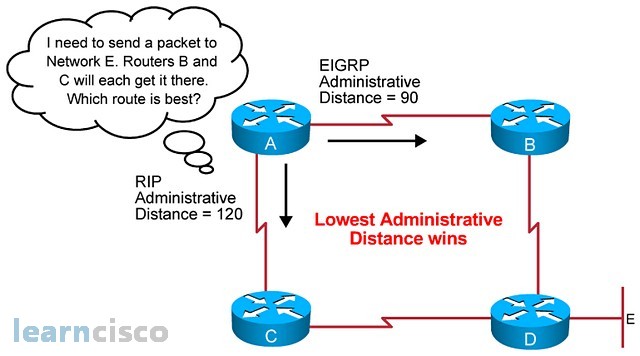In this lesson we will describe and classify the different available protocols and then focus on the routing information protocol (RIP) to provide configuration examples on Cisco routers. We will also describe the use of monitoring and troubleshooting tools available in IOS.
What is a Routing Protocol?
Routing protocols define the rules for the dynamic exchange of information between routers to build the routing table for a routed protocol. The routed protocol will then use that information to drive the packets and find the best path to a destination. So the routing protocols are like the builders of a map to a city and then the routed protocol is the one driving the packets using the information from the map to go around the city. The analogy is complete if you think of the builders of the map adjusting continuously to changes in terms of new streets, streets that may be blocked or no longer available.
In the TCP/IP protocol stack, the routed protocol is IP and the routing protocols abound; RIP and EIGRP are examples of that. Now different routing protocols will be more accurate in maintaining the topology information and learning about changes. Some others will be more efficient in doing so and will adjust quickly to topology changes. In comparing, routing protocols will use three major criteria: first, how routers discover each other and start exchanging routing information; second, how they learn about the network; and third, how they adjust to network changes and how quickly they recover and find the alternative path.
Autonomous Systems: Interior or Exterior Routing Protocols
In understanding how routing protocols work, we need to understand the context in which they work. One first way to classify them could be as exterior gateway protocols or interior gateway protocols. The concept is fairly simple. Interior gateway protocols (IGP) will be those routing protocols working inside of an autonomous system. Exterior gateway protocols (EGP) are those connecting or working between autonomous systems. An autonomous system is a collection of networks under a common administration and sharing a common routing strategy and policies. So it is common to see a set of routing protocols working or configured as part of an organization’s networks, even if that organization spans across multiple geographic areas.

The concept is more of an administration scope and not necessarily a geographic scope. You could have a WAN between two networks but if those two networks are maintained by the same administration team under the same routing policies and belonging to the same organization, then those routing protocols are interior.
In real life, the concept of an autonomous system is very much related to the Internet. All networks connected to the Internet will either have their own autonomous system number or will belong to their service provider’s autonomous system. In that sense, the only exterior gateway protocol is BGP, which is a routing protocol we speak out in the Internet. The others there are considered interior gateway protocols and are typically run within the confines of an organization’s private networks.
Classes of Routing Protocols
The concepts of IGPs and EGPs tell you a bit about how the routing protocols work. Typically, EGPs are more scalable to be able to process Internet routes, so they are geared toward high volumes and millions of routes. The IGPs will be geared toward the thousands of routes and perhaps thinking about convergence times and not so much about scalability.
Another way to classify routing protocols is by looking at these categories:
- Distance vector protocols – more traditional and typically more inefficient in learning and adjusting to network changes. Examples of this category are RIP and IGRP.
- Link state protocols – more efficient and more stable than distance vector and are thought of with convergence times in mind. OSPF and ISIS are both link state protocols.
- Hybrid routing – the approach is to combine some aspects of link state and some aspects of distance vector algorithms aiming at stability and fast convergence. EIGRP belongs to this category.
Administrative distance: Ranking Routes
In some design scenarios, you will eventually find more than one routing protocol learning information about destinations. Ideally, they should not overlap and advertise the same destinations, but in some cases, you may find that situation. If that is the case, then the administrative distance is a tiebreaker between routing protocols. It is an indication of the priority or trustworthiness of a routing protocol as a source of information. The lower the administrative distance, the more preferred the routing protocol, and so in this example here, where router A is learning information about destination E there EIGRP would be selected as the source of information and therefore EIGRP routes would be followed. EIGRP, after all, has a lower administrative distance.

Now this concept is not to be confused with the concept of cost or metric. The administrative distance is a tiebreaker between routing protocols as sources of information, whereas the cost or metric is the tiebreaker between different paths toward the same destination. The first question a router will ask is who wins in terms of routing protocols and so the first criteria that will be evaluated is the administrative distance. Once a routing protocol has been selected as the trusted source, then if there are multiple ways or paths to get to the same destination as advertised by the same routing protocol, then the cost will be the tiebreaker to select the path. The following table summarizes the administrative distance for some of the most common dynamic routing protocols:
| Routing Protocol | Administrative Distance |
|---|---|
| Directly Connected Interface | 0 |
| Static Route | 1 |
| EIGRP | 90 |
| OSPF | 110 |
| RIP | 120 |
Classful Routing Protocol
Another important classification that will tell you a lot about how routing protocols operate is whether they are classful or classless routing protocols. The main difference is the way they operate in the presence of subnet masks. A classful routing protocol will not include the subnet mask along with the route advertisement. This means that they do not support VLSM or Variable Length Subnet Masks.
The drawbacks of this method are critical. You will not be able to use multiple sizes of subnet masks; therefore, the IP address designed in allocation is less flexible. You will also not be able to summarize the routing advertisements and that has an impact on the routing table size and router performance. RIP version 1 and IGRP are both classful routing protocols.
Classless Routing Protocol
Protocols like RIPv2, EIGRP, OSPF, IS-IS are classless routing protocols and this means that they will advertise the subnet mask along with the prefix of the destinations that are trying to advertise. This means that you can have an environment with multiple subnet mask sizes; this is called VLSM or Variable Length Subnet Masks. IP address allocation and assignment is a lot more flexible, for example, you can think of a /30 mask for a point-to-point link because the /30 will result in only two IP addresses, that is very efficient. You are not wasting IP addresses in such a small subnet.
Also, summary routes can be manually controlled within the network and that allows for more control over routing table sizes and a more stable routing process. This is because route summarization is the process of advertising fewer routes by sending summaries of blocks of networks. This is accomplished by sending prefixes with smaller masks. It would be similar to simply sending a map advertising the way or the road to the city without the specifics of the streets and areas of the city. This not only makes for a more simple map, but it is also more stable because if a street of the city is blocked, the map to the city will not change.
Our Recommended Premium CCNA Training Resources
These are the best CCNA training resources online:
Click Here to get the Cisco CCNA Gold Bootcamp, the most comprehensive and highest rated CCNA course online with a 4.8 star rating from over 30,000 public reviews. I recommend this as your primary study source to learn all the topics on the exam.

Want to take your practice tests to the next level? AlphaPreps purpose-built Cisco test engine has the largest question bank, adaptive questions, and advanced reporting which tells you exactly when you are ready to pass the real exam. Click here for your free trial.
